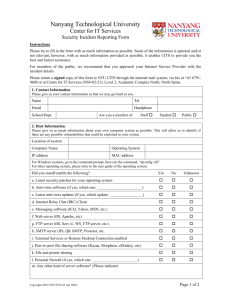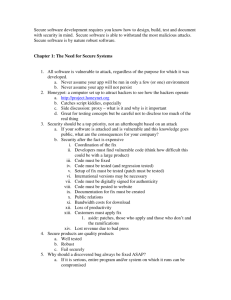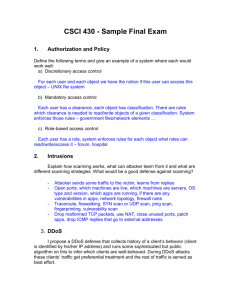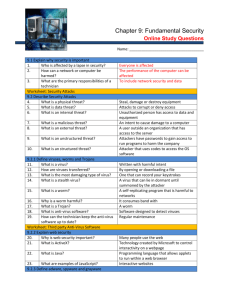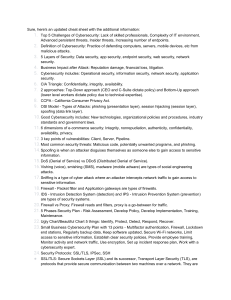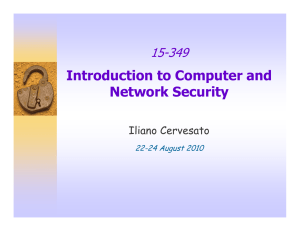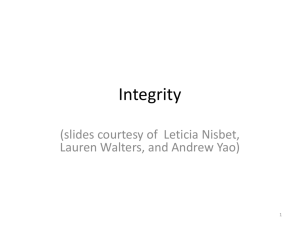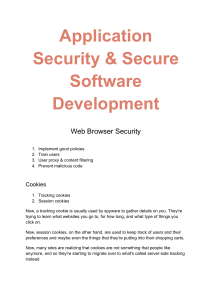Chapter 11 Lab Manual Review Questions and Answers
advertisement
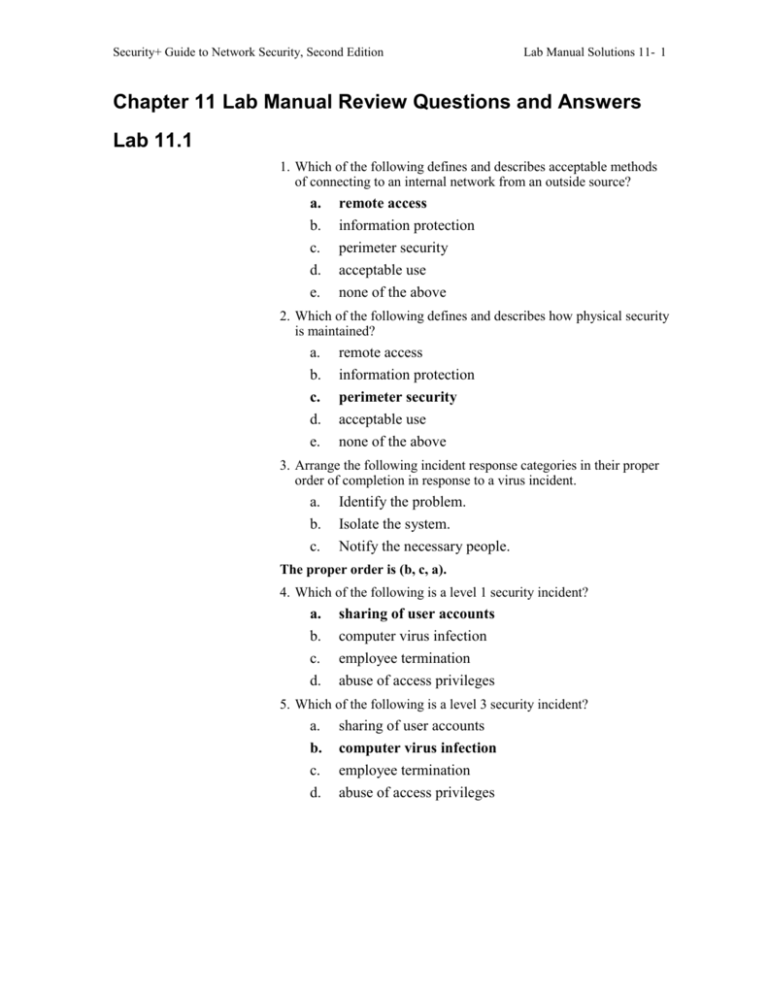
Security+ Guide to Network Security, Second Edition Lab Manual Solutions 11- 1 Chapter 11 Lab Manual Review Questions and Answers Lab 11.1 1. Which of the following defines and describes acceptable methods of connecting to an internal network from an outside source? a. b. c. d. e. remote access information protection perimeter security acceptable use none of the above 2. Which of the following defines and describes how physical security is maintained? a. b. c. d. e. remote access information protection perimeter security acceptable use none of the above 3. Arrange the following incident response categories in their proper order of completion in response to a virus incident. a. b. c. Identify the problem. Isolate the system. Notify the necessary people. The proper order is (b, c, a). 4. Which of the following is a level 1 security incident? a. b. c. d. sharing of user accounts computer virus infection employee termination abuse of access privileges 5. Which of the following is a level 3 security incident? a. sharing of user accounts b. c. d. computer virus infection employee termination abuse of access privileges Security+ Guide to Network Security, Second Edition Lab Manual Solutions 11- 2 Lab 11.2 1. Policies have the greatest effect on _________. a. managers b. c. d. users IT staff auditors 2. Categorize each of the following as either “M” (what policies must do) or “S” (what policies should do). a. b. c. d. e. f. g. Describe what is covered by the policies. State why the policy is needed. Be implemented and enforceable. Define contacts and responsibilities. Be concise and easy to understand. Balance protection with productivity. Discuss how violations will be handled. a. (S), b. (M), c. (M), d. (S), e. (M), f. (M), g. (S) 3. You must have management support to be able to implement a security policy. True or False? 4. Who should serve on a security committee to determine security policy requirements? a. b. c. d. management IT staff users all of the above 5. Which of the following are reasons for resistance to security policies? (Choose all that apply.) a. b. Employees do not like change. Security policies are illegal. c. d. Employees fear being spied on. all of the above Security+ Guide to Network Security, Second Edition Lab Manual Solutions 11- 3 Lab 11.3 1. Arrange the following in their proper order within the forensic process. a. b. c. d. e. analysis collection examination preparation documentation The correct order is d, b, c, a, e. 2. In network forensics, it is essential to keep track of the chain of custody when handling evidence. True or False? 3. When responding to an incident, you should do which of the following? a. b. c. d. e. Examine log files. Look for sniffers. Look for remote control programs. Look for file sharing programs. all of the above 4. If you are under attack from a hacker, what should you do first? a. b. c. d. Observe the attacker. Chase the attacker away. Back up the system. Catch the attacker. 5. If you want to prosecute an attacker, you should contact legal counsel immediately. True or False? 6. What is the primary reason that most computer crimes go unpunished? a. b. c. d. lack of education privacy issues lack of resources none of the above 7. A(n) _________ attack occurs when an attacker impersonates another system by using its IP address. a. b. c. d. DDoS IP spoofing IP splicing IP tampering Security+ Guide to Network Security, Second Edition Lab Manual Solutions 11- 4 8. A(n) _________ attack occurs when an attacker denies legitimate users access to a system. a. b. c. d. DDoS IP spoofing IP splicing IP tampering 9. A(n) _________ attack occurs when an attacker hijacks an active session. a. b. c. d. DDoS IP spoofing IP splicing IP tampering 10. Which of the following is the first step of risk management? a. b. c. d. e. monitoring evaluation of control management threat assessment inventory 11. In which of the following stages of risk management is a vulnerability list created? a. b. c. d. e. monitoring evaluation of control management threat assessment inventory 12. Which of the following stages of risk management is ongoing as the process evolves? a. b. c. d. e. monitoring evaluation of control management threat assessment inventory 13. In what area of security management do you use an intrusion detection system (IDS)? a. Security Technology Management b. c. Vulnerability Management Systems Availability 14. In what area of security management do you maintain a library of Security+ Guide to Network Security, Second Edition Lab Manual Solutions 11- 5 attack signatures? a. b. Security Technology Management Vulnerability Management c. d. Exploitation Management Systems Availability 15. Who is typically responsible for overseeing the risk management process? a. b. c. IT manager chief executive officer chief financial officer d. chief security officer
